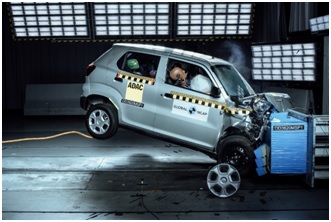

Context
The government approved a Draft GSR (general statutory rules) notification seeking comments on a proposal to introduce the Bharat New Car Assessment Program (Bharat-NCAP).
Background
- The introduction of the Bharat NCAP would entail giving vehicles a star rating based on their performance in crash tests.
- The voluntary programme aligns existing test regulations at home with global crash testing protocols.
Analysis
What is Bharat NCAP?
- It is a new car safety assessment programme(NCAP).
- It proposes a mechanism of awarding ‘Star Ratings’ to automobiles based upon their performance in crash tests.
- The proposed assessment will allocate Star Ratings from 1 to 5 stars.

|
Why Car Safety Star Ratings is important?
|
- BNCAP standard is aligned with global benchmarks and it is beyond minimum regulatory requirements.
- Rollout: BNCAP will be rolled out from April 1, 2023.
- Applicability: It will be applicable on type-approved motor vehicles of category M1 with gross vehicle weight less than 3.5 tonnes, manufactured or imported in the country.
- M1 category motor vehicles are used for the carriage of passengers, comprising eight seats, in addition to driver’s seat.
|
Global new car assessment programs (NCAP)
|
How would the vehicles be evaluated?
- Parameters: Bharat NCAP would assign vehicles between one and five stars on parameters such as
- Adult Occupant Protection (AOP)
- Child Occupant Protection (COP)
- Safety Assist Technologies (SAT)
|
Offset collisions are those where one side of a vehicle’s front end and not the full width hits the barrier. |
- It would study frontal impact, side impact and the possibility of a door opening up after a crash.
- The major change proposed with the Bharat NCAP is the speed for frontal offset crash testing – at 64 kmph in comparison to the existing tests conducted at 56 kmph.
|
Criteria for star rating of vehicles: The protocol varies among NCAPs. According to draft notification the voluntary Bharat NCAP would assign vehicles between one and five stars, based on full vehicle crash test in three categories —
The child must not be ejected from the CRS and his/her head must be contained within the shell of the CRS preventing any outside blow following a crash.
Mechanism: The car is crashed into an aluminium deformable barrier impersonating an opposing force of the same magnitude of a crash-like situation, with a 40% overlap.
Incentives: Vehicles that can accommodate a broad variety of child seats available in the domestic market would be rewarded.
|
Why does India need to crash-test vehicles?
- Indian vehicles have historically not been crash-tested in the country.
- Despite being home to only 1% of the world’s vehicles, India shoulders 11% of the global road crash fatality burden, according to the non-profit Save Life Foundation.
|
NCRB Data
|
Why safety is not the priority?
- Structural issues: Vehicles sold in India are often sub-par in terms of safety features like? the requisite?number?of?airbags, and have unstable structures, unable to protect their occupants in the event of a road crash.
- More focus on price: Price sensitive market allows car makers to focus on price than safety because Indians prefer budget friendly vehicles.
- Lack of regulation: India’s Central Motor Vehicle Rules (CMVR) mandate a safety and performance assessment. However, this does not involve a crash test rating.
Expected Benefits
- Export worthiness: It is intended to increase the export-worthiness of vehicles and competition on safety parameters among manufacturers, as well as instill consumer confidence in their safety.
- Reduction in road accidents: India aims to reduce road accidents and deaths by 50 percent by 2030.
- Passenger safety: It will ensure structural and passenger safety in cars.
- Help in making India atmanirbhar: This program will make automobile industry in India Atma Nirbhar and will make India the top automobile hub worldwide.
|
How is BNCAP aligned with GNCAP? |
How BNCAP is different from other NCAPs? |
|
|
Summing Up
The proposed move follows India’s focus on “zero tolerance for road accidents”. India is striving to reduce road accidents by 50% by the year 2025.
Bharat NCAP rating criteria would emerge as a turning point in the domestic automotive sector in terms of product, technology and safety, since it would provide a platform that would test vehicular safety as per Indian conditions.



